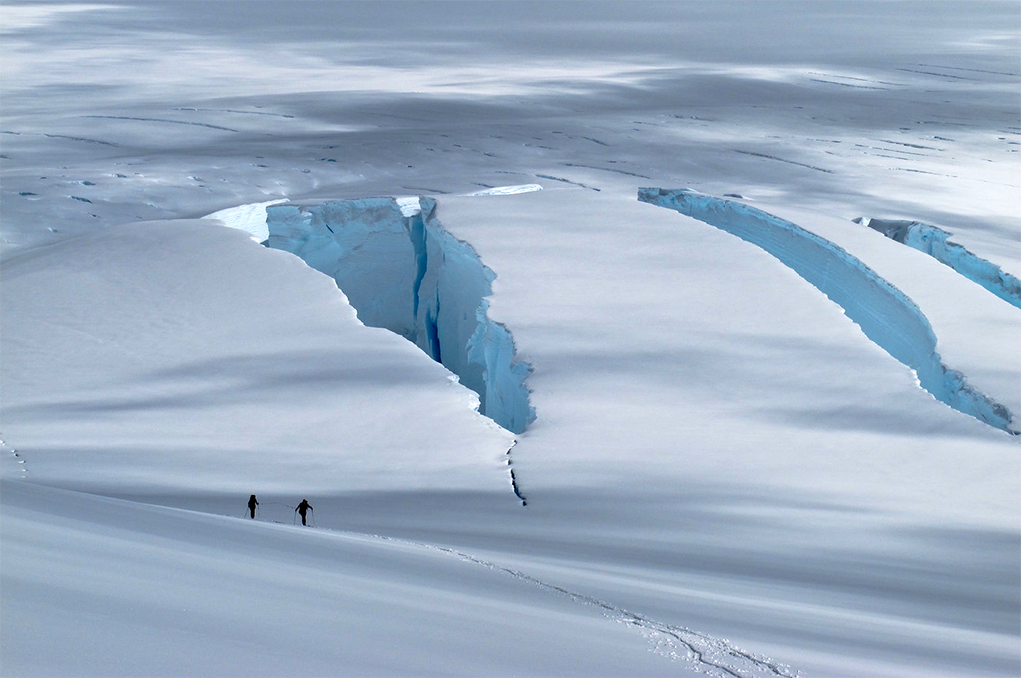



Although no previous sailing experience is required, all members will need to have ski-mountaineering experience and be comfortable skiing all snow-types on slopes up to 30°. It is also preferable that members know how to rope up to cross glaciers and how to perform a crevasse rescue. If this is new to you we can recommend suitable courses that teach these skills so that you can make the most of your expedition to Antarctica.
All skiing is on heavily glaciated mountains, above fjords studded with icebergs. Due to the heavily glaciated nature of the terrain we will ascend most mountains roped-up, and will return, un-roped if it is safe to do so, by our route of ascent. While it is unlikely that we will be skiing champagne powder, we will be skiing slopes up to 35° in one of the most spectacular places in the world with truly breathtaking back-drops.
Although most of the ascents will be completed on skis, using skins and ski crampons, there may be short sections, particularly close to the summits, where we may need to fix skis to our rucksacks and use crampons and an ice-axe.
With mountains ranging from 500m to 2000m, ascents can take between 3 and 8 hours each day, either from the yacht or from a high base camp.
Being a maritime climate, the temperature on the Antarctic Peninsula in summer is relatively mild. Ranging from -5°C to +5°C, it is similar to winter in Scotland.
It is likely that we will have cloudless, still days, as well as periods of thick cloud, white-out and wind. The Antarctic Peninsula sits a little below the path of the depressions that circulate Antarctica. These pass quickly, and then the weather is generally settled. The length of the expedition means that we have a good chance of experiencing all weathers, and to make the most of the clear periods when they arrive.
Icebird is set up to receive GRIB wind-forecast information and SkyEye satellite imagery. Used together, these allow us to make relatively accurate weather forecasts.
Although the Drake Passage is renowned for its bad weather and rough seas, we time our crossings to make the most of the best conditions. Depressions pass through the Drake Passage quickly, after which the conditions are usually suitable for a crossing. If we need to wait for a day or so for a depression to pass, we may position ourselves closer to Cape Horn where we can spend a day hill-walking on the Chilean side of the Beagle Channel.
We will time our crossing to give us the best chance of perfect sailing conditions - moderate winds and 2-3m swell. Sometimes the wind may be stronger and the swell may be larger, and sometimes we may have to motor due to lack of wind. Our timing ensures that our crossing is as comfortable as possible.
Although not everyone gets sea-sick, it is best to come expecting some discomfort, and make use of medications which work for most people. After a day or two most people feel a lot better. What’s more, crossing the Drake Passage is all part of the adventure and, in a sense, a rite of passage that is necessary to enjoy the privilege of being virtually alone in the world’s largest wilderness.
Although everyone is expected to help sail as part of a watch system (usually 3 hours on and 6 hours off), no previous experience is necessary as all instruction is given.
Since this is an expedition, everyone is expected to help cook and keep the yacht clean. We will have a cooking rota and will pair up for this. Don’t worry if you aren’t the world’s best cook – we can suggest easy recipes, or you can throw some excellent argentine beef on the BBQ. Cath is always on hand to help and advise as well, and of course when you come off a mountain there will be a wonderful hot meal awaiting you, as well as hot showers.
Yes. The yachts have a satellite phone that expedition members may use at cost price. Emails, which are billed by size, are sent via satellite phone and accounts can be set up for each guest for a small fee. Note that there is no internet access, and that you will not be able to access your usual email account.
All food is provided on the yacht, and all mountain food is provided except for freeze-dried main meals for camping. It is recommended that each member bring six freeze-dried main meals since these are not available in Ushuaia and personal preferences vary.
A full clothing and equipment checklist will be sent to all expedition members once they have been accepted on the expedition and booking is confirmed, although please feel free to email us any specific enquiries.
Many airlines regularly fly to Buenos Aires, from where several flights depart daily to Ushuaia. We recommend booking flights early to get the best prices, and to overnight in Buenos Aires on your return in case of delays to the flight from Ushuaia. You may also wish to extend your stay at either end to see the sights of Buenos Aires, or to hike around Ushuaia or in Patagonia. Please note that flights to Ushuaia are not included in the cost of the expedition.
Although most people visiting Argentina for less than three months can purchase their visa at the airport when they arrive in Argentina, we recommend that you check the visa requirements according to your nationality.